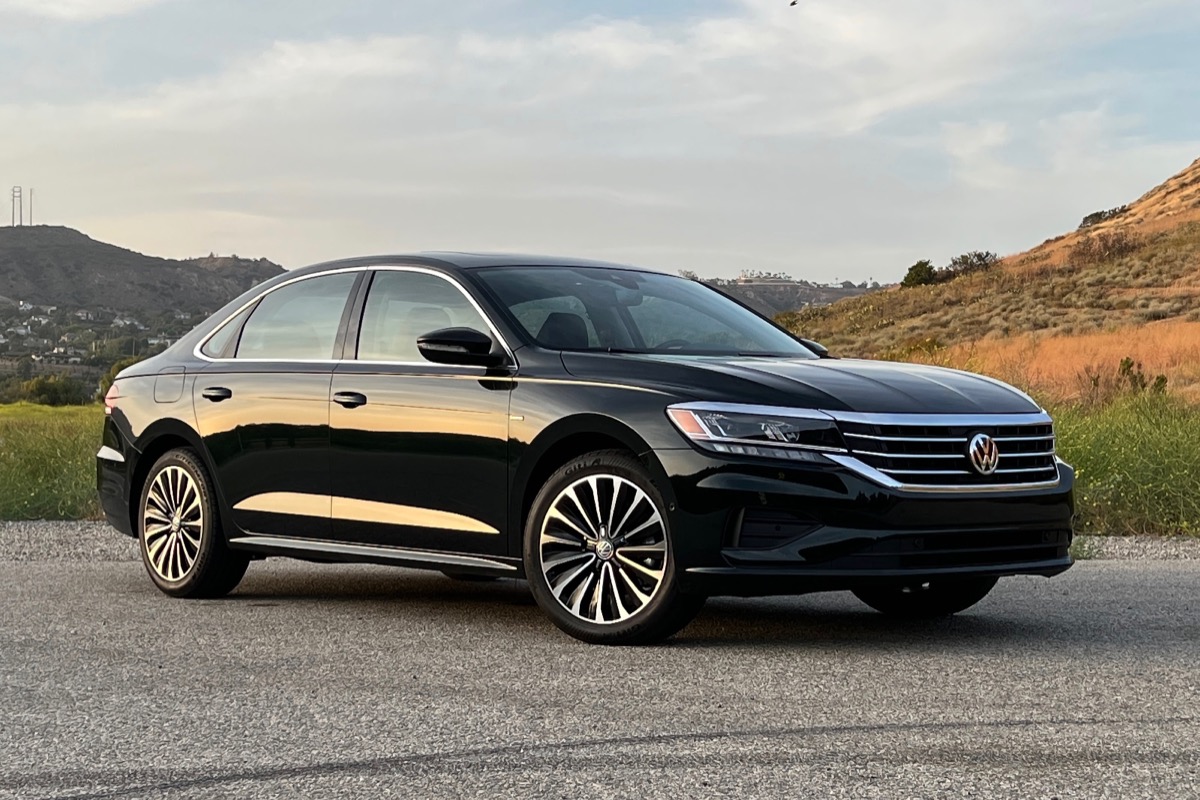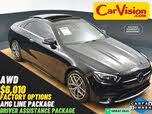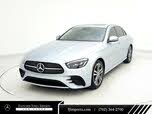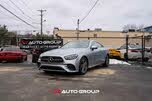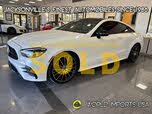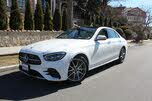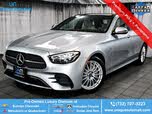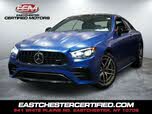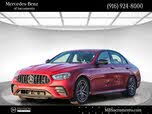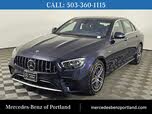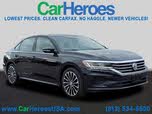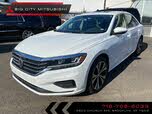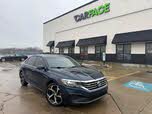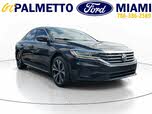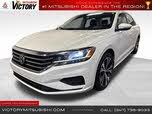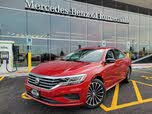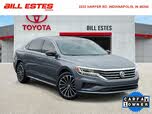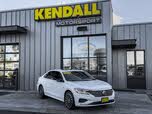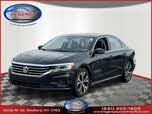2022 Mercedes-Benz E-Class vs 2022 Volkswagen Passat
Overview | ||
MSRP | $54,950 | $27,575 |
Average price | $45,969 | $19,238 |
Listings | ||
Ratings & Reviews | ||
User reviews | ||
Expert reviews | 8.2 out of 10Read full review | 6.0 out of 10Read full review |
Pros & cons | Pros
| |
Summary | Following a substantial refresh for the 2021 model year, the 2022 Mercedes-Benz E-Class lineup sees few changes. The most significant of them is the cancelation of AMG E63 and E63 S variants. Reportedly due to supply chain problems, V8 engines are being dropped from much of the 2022 Mercedes-Benz lineup. That leaves the E-Class with turbocharged four-cylinder and six-cylinder power plants. Additionally, automatic high-beam headlights are standard on all 2022 E-Class models, and a couple of paint colors are new. With the coupe and convertible body styles, rear USB charging ports are now standard equipment. | First came the Dasher in 1974, then the Quantum in 1982, then the Passat in 1990. None became household names like the Honda Accord or Toyota Camry, partly because the Passat and its progenitors appealed to a small contingent of Americans seeking European design, engineering, and driving dynamics in a car often characterized as a bargain-priced Audi. But in the midsize sedan segment, a reputation for reliability and efficiency, not design or handling, is king. Tired of compromise, Volkswagen "Americanized" the Passat for the 2011 model year, moving production to a new factory in Chattanooga, Tennessee. The car's blandly attractive design, huge interior, big trunk, and soft ride seemed to be just what U.S. customers wanted, along with a ”Made in the USA” label. But those potential buyers had moved on to SUVs, and the new Passat alienated some of the VW faithful. The Dieselgate scandal didn't help the Passat, either. VW nailed the car's coffin shut when the family car segment began to wither rapidly. So now, the Passat departs the U.S. market, effectively replaced by the Tiguan and Atlas SUVs and leaving the Jetta to serve people who still want a sedan wearing a VW logo on its grille. |
Video | No video found | No video found |
Popular Features & Specs | ||
Engine | 2.0L 255 hp I4 | 2.0L 174 hp I4 |
Drive Train | RWD | FWD |
Seating Capacity | 5 | 5 |
Horsepower | 255 hp @ 5800 rpm | 174 hp @ 5200 rpm |
MPG City | 23 | 24 |
MPG Highway | 31 | 36 |
Engine | ||
Engine Name | 2.0L 255 hp I4 | 2.0L 174 hp I4 |
Torque | 273 lb-ft @ 1800 rpm | 206 lb-ft @ 1700 rpm |
Horsepower | 255 hp @ 5800 rpm | 174 hp @ 5200 rpm |
Drivetrain | RWD | FWD |
Fuel Economy | ||
MPG City | 23 | 24 |
MPG Highway | 31 | 36 |
Interior | ||
Seating Capacity | 5 | 5 |
Key Features | ||
Navigation System | Standard | |
Sunroof/Moonroof | Standard | Standard |
Safety | ||
Front Crash Overall | 5 | 3 |
Side Crash Overall | 5 | 5 |
Dimensions & Capacity | ||
Cargo Space | 13.1 cu ft | 15.9 cu ft |
Curb Weight | 3781 lbs | 3369 lbs |
Height | 57.8 in | 58.7 in |
Length | 194.3 in | 193.6 in |
Width | 81.3 in | 72.6 in |
Wheelbase | 115.7 in | 110.4 in |
Maximum Payload | 1444 lbs | 937 lbs |
Number of doors | 4 | 4 |
The 2022 Mercedes-Benz E-Class was available in coupe, convertible, sedan, and station wagon body styles, offering a variety that was hard to match. The E350 sedan featured a turbocharged four-cylinder engine, while the E450 variants came with a turbo 3.0-liter inline-six engine equipped with EQ Boost 48-volt mild-hybrid technology. Rear-wheel drive was standard, with 4Matic all-wheel drive as an option. The AMG E53 models, except for the All-Terrain wagon, used a more powerful version of the E450’s engine. The AMG E53 Cabriolet, tested with a base price of $85,400, reached an as-tested MSRP of nearly $110,000 with options. The car's design, especially with AMG styling, larger wheels, and a matte-blue paint finish, was described as sensational. Inside, the high-end spec featured bright digital displays, glow-in-the-dark air vents, Burmester speaker grilles, and luxurious leather, exuding pure luxury.
The 2022 Volkswagen Passat, in its final year, introduced a Limited Edition model priced at $31,570. Only 1,973 units were produced, commemorating the year the Passat first went on sale in Europe. The Limited Edition featured exclusive 18-inch alloy wheels, black mirror caps, and special badges, with a unique Racing Green paint option. The interior boasted Mauro Brown leather upholstery, fake wood trim, and special seat tags. Despite its age, the Passat's design remained upscale, with a freshening in 2020 extending its appeal. However, the interior mixed inexpensive plastics and outdated technologies, such as a 6.3-inch touchscreen infotainment system and a small driver information display. The cabin's modernity was highlighted by integrated dashboard air vents and metallic detailing, adding a touch of European sobriety.
The 2022 Mercedes-AMG E53 models featured a 3.0-liter turbo-six engine with EQ Boost mild-hybrid technology, generating 429 horsepower and 384 pound-feet of torque. The engine provided robust throttle response across a wide rev range, with a 0-60 mph acceleration time of 4.4 seconds. The AMG Speedshift nine-speed automatic transmission and AMG Performance 4Matic+ variable AWD system ensured power delivery to the pavement. The AMG Dynamic Select driving modes allowed for character adjustments, while the AMG-tuned air suspension and performance exhaust system enhanced the driving experience. The E53 Cabriolet excelled as both a quiet cruiser and a spirited performer on twisty roads, with features like heated wiper blades and AWD making it suitable for winter driving.
The 2022 Volkswagen Passat was powered by a 2.0-liter turbocharged four-cylinder engine, producing 174 horsepower and 206 pound-feet of torque. The six-speed automatic transmission drove the front wheels, with no AWD option available. The engine's torque curve provided adequate power for commuting and highway cruising, but the car lacked immediate passing power. The transmission's Sport mode improved responsiveness without significantly affecting fuel efficiency, with observed fuel economy of 30.7 mpg. The Passat's ride quality prioritized comfort, though it felt jittery on city streets and conveyed impacts through its aging architecture. The car's handling on twisty roads revealed traditional German traits, with flat cornering and accurate steering, making it enjoyable to drive in such conditions.
The Mercedes-AMG E53 Cabriolet comfortably transported four adults, with an Aircap system reducing cabin turbulence when the top was down. The focus was on driver and front passenger comfort, with standard heated seats, a heated steering wheel, and available rapid-heating front seats and heated armrests. The Airscarf neck-warming system and sun-reflective leather added to the comfort. The triple-layer acoustic soft top kept the cabin cool and quiet in hot weather. The test car featured multi-contour front seats with massage and an Air Balance interior fragrance system. The trunk offered 9.5 cubic feet of cargo space with the top raised, reduced by half when the top was dropped.
The Volkswagen Passat's hallmark was its spacious cabin, accommodating five adults with ample legroom and dual-zone climate control. The Limited Edition's front seats offered eight-way power adjustment but lacked separate bottom cushion angle adjustment, affecting comfort. The rear seats provided excellent leg support and comfort, with air conditioning vents and USB ports. Storage space was good, though door-panel bins were lined with hard plastic. The trunk offered 15.9 cubic feet of space, with no underfloor trays or side bins, requiring secure placement of items. The trunk lid could be opened remotely but was not power-operated.
The Mercedes-Benz E-Class featured the MBUX infotainment system with two 12.3-inch screens forming the foundation. The system was complex yet user-friendly, with swipe and scroll functions on the steering wheel buttons requiring acclimation. Interaction options included the touchscreen, physical controls, digital voice assistant, and touch-sensing buttons on the steering wheel. The system included Apple CarPlay, Android Auto, WiFi service, and an augmented reality video overlay for navigation. The test car had a Burmester surround-sound audio system with metal speaker grilles. Challenges included remembering menu locations and accidental activation of the digital assistant.
The Volkswagen Passat's infotainment system featured a 6.3-inch screen with standard App-Connect smartphone connectivity, SiriusXM satellite radio, and Bluetooth for two devices. Car-Net connected service plans included a WiFi hotspot. The R-Line and Limited Edition added HD Radio, navigation with voice recognition, and a Fender premium audio system. The voice recognition system worked for simple commands but struggled with complex ones. The Fender audio system was praised for its clarity and range, making it a standout feature.
The Mercedes-Benz E-Class included standard forward collision warning with pedestrian detection, automatic emergency braking, blind-spot monitoring, and rear cross-traffic alert. The Cabriolet featured pop-up rollbars for rollover protection. Pre Safe and Pre Safe Sound were standard, preparing the cabin and protecting ears during a collision. Active Parking Assist, a surround-view camera system, and rain-sensing wipers with Magic Vision Control were also standard. The Driver Assistance Package added adaptive cruise control, Active Steering Assist, front automatic braking for cross traffic, Evasive Steering Assist, Active Lane Keeping Assist, Active Blind Spot Assist, Active Emergency Stop Assist, and Pre Safe Plus. The package was praised for its effectiveness, particularly the adaptive cruise control and Active Steering Assist.
The Volkswagen Passat SE included standard forward-collision warning with pedestrian detection, automatic emergency braking, blind-spot monitoring, rear cross-traffic alert, automatic rear braking, lane-departure warning, lane-keeping assistance, and adaptive cruise control. Car-Net connected services offered Family Guardian alerts and emergency assistance calling. The R-Line trim added automatic high-beam headlights, while the Limited Edition featured adaptive headlights, front and rear parking sensors, and a park-assist system. The lane-keeping assistance system was noted for making unnecessary corrections, and the reverse automatic braking system was overly sensitive. The adaptive LED headlights received high ratings from the IIHS, but the NHTSA gave the Passat a four-star overall rating, with a three-star rating for frontal-impact protection.
CarGurus highlights

According to CarGurus experts, the overall rating for the 2022 Mercedes-Benz E-Class is 8.2 out of 10, while the 2022 Volkswagen Passat scores 6.0 out of 10. Based on these ratings, the Mercedes-Benz E-Class is the clear winner, offering superior luxury, performance, and technology. If you can afford the higher price tag, the E-Class provides a more rewarding and enjoyable driving experience.
Choose the 2022 Mercedes-Benz E-Class if:
Shop Now- You desire a luxurious and high-tech interior with advanced infotainment and safety features.
- You want a versatile vehicle available in multiple body styles, including a high-performance AMG variant.
- You prioritize a blend of comfort and performance, with options for both relaxed cruising and spirited driving.
Choose the 2022 Volkswagen Passat if:
Shop Now- You need a spacious and comfortable cabin with ample legroom for rear passengers.
- You prefer a vehicle with good fuel efficiency and a large fuel tank for fewer stops at the gas station.
- You seek a budget-friendly sedan with essential safety features and a premium audio system.

By: CarGurus + AI
At CarGurus, our team of experienced automotive writers remain at the heart of our content operation, conducting hands-on car tests and writing insightful guides that are backed by years of industry experience. To complement this, we are harnessing AI to make our content offering more diverse and more helpful to shoppers than ever. To achieve this, our AI systems are based exclusively on CarGurus content, ratings and data, so that what we produce is both unique to CarGurus, and uniquely helpful to car shoppers.
